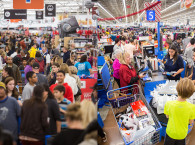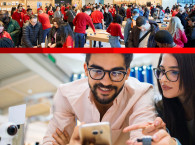
- John Minchillo
CEA estimates Americans will spend $39.9 billion over the entire 2014 Thanksgiving shopping weekend. In total, 113.2 million U.S. adults (46%) shopped or planned to shop over the holiday weekend from Thanksgiving Day to Cyber Monday—down 18 million shoppers from 2013. While the number of shoppers declined in 2014, consumers who shopped spent more, with an average of $371—a 4.8% increase over 2013.
“Black Friday and Cyber Monday were once relatively independent shopping days, but they’ve expanded into a 10-day shopping period that encompass the days ahead of Black Friday as well,” said DuBravac. “A drop in shopping traffic over the holiday weekend is likely due to transactions being pulled forward, as retailers offer more deals in-stores and online earlier in the week than in previous years.”
Among the 51.2 million American adults who bought or were planning to buy technology products over the weekend, TVs (37%) were the most popular CE device purchased or planned to purchase. Tablets (35%), notebook computers (23%), videogame consoles (23%) and portable wireless speakers (23%) were the other most frequently anticipated tech purchases over the 2014 Thanksgiving weekend.
“While televisions are always a popular item for shoppers during the Thanksgiving shopping weekend, consumers showed a remarkable appetite for them this year,” said DuBravac. “We’re in a ‘sweet spot’ for TV purchases, consumer demand appears to be driven by three main factors: phenomenal deals across all TV categories, movement into a new upgrade cycle for consumers and interest in new technologies such as 4K Ultra HD.”
Of US adults who shopped this Thanksgiving weekend and bought tech products, 45% did so online (on par with 2013) and 77% shopped in-store (a 10% decrease from 2013).
According to CEA’s holiday outlook, total tech spending during the entire holiday shopping season will increase 2.5%—up from 0.9% growth in 2013—to reach a record $33.76 billion.

- John Minchillo
Online Shopping
Consistent with CEA’s earlier predictions (CEA’s holiday research and 2014 Pre-Black Friday Report), online purchases contributed significantly to shopping totals this year. Of those Americans that shopped online, consumers cited convenience (88%) as their top reason for shopping online, followed by avoiding crowds (78%) and finding better or similar deals online compared to in stores (77%).
About 30 million US adults (12%) planned to shop on Cyber Monday, up 2.4 million shoppers over last year. Of those planning to shop online on Cyber Monday, most plan to shop for clothing (61%), followed by books or music (44%), tech or tech accessories (38%) and toys (38%).
Also according to the Consumer Electronics Association, more than half (58%) of shoppers who use mobile devices, such as smartphones and tablets, indicate they prefer to look up information on their devices while shopping, rather than talk to store employees—especially among men and shoppers age 25–44—according to a new report “Enhancing the In-Store CE Retail Experience Using Mobile Devices” released by the CEA.
Additionally, nearly two-thirds (62%) of mobile shoppers indicate they perceive the information they gather via their mobile device as more beneficial than the information available in-store via product displays or sales literature. Mobile shoppers most often use their mobile devices for assistance when shopping for electronics (60%) than any other product type. Following electronics, mobile shoppers most frequently use their devices while shopping in physical retail stores for groceries (55%), apparel (47%), shoes (45%), and health and beauty products (39%).
While shopping specifically for electronics, mobile shoppers use their devices to compare prices (63%), read customer ratings or reviews (52%) and search the Internet for more information (51 percent). Among those who turn to mobile devices for additional product information while shopping, seven in 10 conduct a general Internet search (69%) while half visit a store-specific website (52%), use a store-specific app (47%) or visit a manufacturer-specific website (46%).
At the same time, they see the benefit of having a relationship with retailers as 81% of mobile shoppers indicate they would be willing to share some form of personal data with retailers in exchange for benefits in return. Current GPS location information (48%) is the most common type of data mobile shoppers are willing to share, followed by user profile information (46%) and personal contact information (40%).
Cyber Monday Results 2014
Cyber Monday continues to outpace Black Friday and Thanksgiving as the biggest online shopping day of the year with online sales up 8.5% over 2013, according to the annual IBM Digital Analytics Benchmark Reports.

Available here: InfoGraphic: Shopping trends from Cyber Monday 2014
The Monday after Thanksgiving remained the busiest day for online shopping over the five day period. Cyber Monday online sales grew by 8.5% over 2013. Average order value was $124.21, down 3.5% year-over-year. Cyber Monday mobile traffic also accounted for 41.2% of all online traffic, up 30.1% over 2013. Mobile sales were also strong, reaching 22% of total Cyber Monday online sales, an increase of 27.6% year-over-year.
As the new digital shopping companion for many consumers, smartphones drove 28.5% of all Cyber Monday online traffic, more than double that of tablets, which accounted for 12.5% of all traffic. Yet, when it comes to mobile sales, tablets continue to win the shopping war—driving 12.9% of online sales compared to 9.1% for smartphones, a difference of 41.5%. Tablet users also averaged $121.49 per order compared to $99.61 for smartphone users, a difference of 22%.
iOS once again led the way in mobile shopping this holiday season, outpacing Android across three key metrics on Cyber Monday. iOS users averaged $114.79 per order compared to $96.84 for Android users, a difference 18.5%; iOS traffic accounted for 28.7% of total online traffic, more than double that of Android, which drove 12.2% of all online traffic; and iOS sales accounted for 17.4% of total online sales, more than four times that of Android, which drove 4.4% of all online sales.
As shoppers returned to work on Cyber Monday, desktop PCs accounted for 58.6% of all online traffic and 78% of all online sales. Consumers also spent more while shopping on their PCs with an average order value of $128.24 compared to $110.72 for mobile shoppers, a difference of 15.8%.
The IBM Digital Analytics Benchmark Cyber Monday 2014 report can be downloaded here.
www.ce.org






